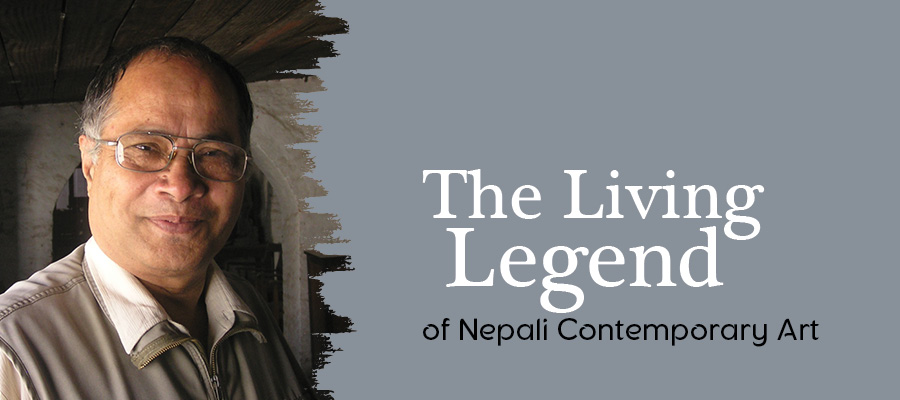Govinda Dangol

Govinda Dangol works are in various styles and media. He creates landscape, still-life and portrait using oil colour, charcoal, pencil and water colour. In some of his works, he also used collage technique. He synthesizes native tradition with modernity. Influenced by tantric and Hindu philosophy he presents pubha painting with new significance using modern techniques of painting. There is spiritual undercurrent in his works. He creates coherence and harmony between human beings and non-living things around him.
His paintings depict the human consciousness through the creative appropriation of abstractionism and the structure of mandala. The arrangement of the squares, circle and gate-like structures in different colours leading toward the centre resembles to the early Nepali mandalas. As the images of principal deity at the centre and subsidiary deities around are missing, his works differ from these early art forms. Early Nepali mandalas are the yantras for meditation and concentration which lead the sadhak’s consciousness toward the central deity where individual self is supposed to unite oneself with the cosmic being. These mandalas are the representation of concepts as represented in the myths. Although the artist takes the geometric structure of early Nepali mandalas, he explores different themes. In the absence of the images of deities, the structure seems abstract. The form, not the content, is its own significance. Synthesizing native tradition with western techniques, Dangol revitalizes the Paubha painting with new significance.
Govinda Dangol creates a mandala with geometric shapes like triangles, squares, rectangles and circles. In some of his mandalas, triangular shapes are more dominant than other, for not only the outlines of the mandalas are triangular but also the combination of the images also lead the viewers toward depth of another triangle. The triangle at the bottom represents yoni, the source of creation, and the image of yoni is further reinforced by another small triangle within the triangle. The combination of colours creates depth and leads the viewers toward the vulva. The square at the centre in rhythmic and fluid colours represents the womb where creation is supposed to take place. The male and female principles in symbolic form are on the process of union through which life continues in the world. Discarding the external world, the artist leads the viewers toward the source of our creation.
Dangol’s compositions depict the creative appropriation of the native tradition and the modern form. Mandalaic form and the concept of the union between the male and female principles are also the elements frequently exploited in Nepali Paubha paintings. In Paubha paintings, mandalas are generally found within circular or square outline, and the images in the periphery lead the viewer toward the central deity. Instead of presenting the figures of deities as in the early paintings, the artist presents only abstract images. However, the theme of union between male and female principles is the same. The compositions break away from the early art form, yet rooted to it. The technique of dividing space with lines and filling them with colours is different. The works appeal the viewers to meditate upon the origin and source of our creation through the creative appropriation of native Nepali art tradition and modern art form.
Dangol’s works recreate new form sharing some of the images and structure of traditional Nepali mandala. The triangles in red colour lie at the centre of the canvas, and it is enclosed by a circle. Along the border of the circle, lotus petals appear in a bit altered form. The contour of the lotus petals, to some extent, resemble to the decorative pattern of the traditional Nepali paintings. All the images and structures like triangle, circle, lotus, rectangle and gate appear to be the integral part of the globe or the universe. The outermost round shape appears solid and three dimensional which encompasses all the images and objects of the universe. Even the sun and the moon are incorporated within it. The structure is created in such way that the viewer’s attention is drawn from periphery to the centre. Thus, the mandala-like structure appears to be the instrument for meditation. The traditional images and icons are not imitated but modified and altered to express the artists’ feeling in response to contemporary context.
Smooth gradation of harmonious colours, organic structure of the overall canvas and the combination of exotic images, icons and symbols trigger to the bizarre and magical experience. Despite the fact that the concrete significances may not be derived, his paintings leave the exquisite esthetic experience in the viewers.